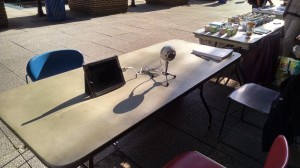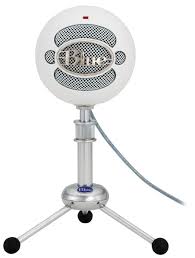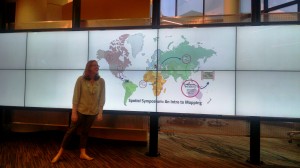In case you didn’t hear, this past Tuesday was the National Day on Writing. And thanks to a bunch of people in the English Department, the Linguistics department, and some other organizations (I think there was a sorority involved somewhere), it went off really well.
I’ve talked before about the Digital Archive of Literacy Narratives, and the project I’ve been working on to find an easy, low amount of hardware way to record using iPad. I blogged a little about it a few weeks ago, and it turns out that the simplest result was the best result.
Here is a picture of the ultimate set up we decided to go with:
As you can see, it is very minimal in its hardware involvement.
We ended up investing in the adapter I mentioned in an earlier entry, which I linked above. The adapter is called the iPad Camera Connector and runs about $30. The snowball you can see in the picture plugs right into the adapter and then it just works. It took me a while to figure out that it needs no other software or authorization on the part of the iPad user – it simply plugs in and works with all the already installed iPad software.
We were at our National Day on Writing table from 10AM until just before 2PM and managed to collect 20 narratives ranging from ‘the first books I read’ to ‘When I learned to read music’ – each one was interesting and wonderful.
Here is a picture of Michael Harker explaining the paperwork to a student who gave a narrative:
 In all, the day was a big success – we even found we could upload the videos into the DALN system right from the iPad.
In all, the day was a big success – we even found we could upload the videos into the DALN system right from the iPad.
I’m pretty happy with how this project is turning out. I learned a lot about iPad interface and hardware (adapters) and a lot about the first things to try. Ooh – and that simplicity is pretty much the best thing ever.
So – in the interest of being as hip as my fellow SIF bloggers, I leave you with a bit of inspiration – not a music video – but drawing I did on a tablecloth and a restaurant. Enjoy:





